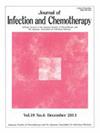Role of continuous infusion in Bayesian-assisted vancomycin dosing guided by area under the concentration-time curve in adults: A scoping review with case series
IF 1.9
4区 医学
Q3 INFECTIOUS DISEASES
引用次数: 0
Abstract
Introduction
Continuous infusion (CI) of vancomycin offers potential benefits in achieving therapeutic drug levels and reducing nephrotoxicity compared to intermittent infusion (IntI). However, no studies from Japan have evaluated CI in detail. This study presents a scoping review with the relevant case series to assess the role of CI in Bayesian-assisted AUC-guided vancomycin dosing.
Methods
The scoping review was performed using PubMed, Web of Science, and Cochrane Library to identify studies published between 2018 and 2024. Data included study design, dosing methods, AUC estimation techniques, outcomes of nephrotoxicity, and therapeutic target achievement. The retrospective analysis was conducted on 15 cases treated with CI at Kumamoto University Hospital. Demographics, nephrotoxicity, and mortality outcomes were analyzed.
Results
The scoping review identified 10 studies, including one randomized controlled trial. Most studies relied on trough concentrations as surrogates for AUC in IntI groups, despite guidelines recommending against this approach. Target exposures for CI varied, with few studies aligning with AUC-guided dosing ranges of 400–600 μg h/mL. Of 15 cases included, four required increased dosing due to high creatinine clearance (CCr), achieving therapeutic targets without nephrotoxicity or mortality. The remaining 11 cases demonstrated variable outcomes, with only 45.5 % achieving therapeutic targets and 54.5 % developing nephrotoxicity.
Conclusions
Although the scoping review highlighted the need for further studies to optimize dosing strategies and clarify the comparative benefits of CI versus Bayesian-assisted IntI, CI may offer potential advantages in achieving therapeutic targets, particularly for adults requiring higher doses, such as those exceeding 3–4 g/day.
持续输注在成人贝叶斯辅助万古霉素给药中以浓度-时间曲线下面积为指导的作用:一项病例系列的范围综述
与间歇输注(IntI)相比,万古霉素连续输注(CI)在达到治疗药物水平和降低肾毒性方面具有潜在的益处。然而,没有来自日本的研究对CI进行详细评估。本研究对相关病例系列进行了范围综述,以评估CI在贝叶斯辅助auc引导万古霉素给药中的作用。方法使用PubMed、Web of Science和Cochrane Library进行范围审查,以确定2018年至2024年间发表的研究。数据包括研究设计、给药方法、AUC估计技术、肾毒性结果和治疗目标的实现。回顾性分析熊本大学医院15例CI治疗病例。分析了人口统计学、肾毒性和死亡率结果。结果纳入10项研究,包括1项随机对照试验。大多数研究依赖于谷浓度作为IntI组AUC的替代品,尽管指南不建议使用这种方法。CI的靶剂量各不相同,很少有研究与auc引导的400-600 μg h/mL剂量范围一致。在纳入的15例病例中,4例由于高肌酐清除率(CCr)需要增加剂量,达到治疗目标,无肾毒性或死亡。其余11例表现出不同的结果,只有45.5%达到治疗目标,54.5%出现肾毒性。尽管范围综述强调需要进一步研究来优化给药策略,并澄清CI与贝叶斯辅助IntI的比较益处,但CI可能在实现治疗目标方面具有潜在优势,特别是对于需要更高剂量的成人,例如超过3-4 g/天。
本文章由计算机程序翻译,如有差异,请以英文原文为准。
求助全文
约1分钟内获得全文
求助全文
来源期刊

Journal of Infection and Chemotherapy
INFECTIOUS DISEASES-PHARMACOLOGY & PHARMACY
CiteScore
4.10
自引率
4.50%
发文量
303
审稿时长
47 days
期刊介绍:
The Journal of Infection and Chemotherapy (JIC) — official journal of the Japanese Society of Chemotherapy and The Japanese Association for Infectious Diseases — welcomes original papers, laboratory or clinical, as well as case reports, notes, committee reports, surveillance and guidelines from all parts of the world on all aspects of chemotherapy, covering the pathogenesis, diagnosis, treatment, and control of infection, including treatment with anticancer drugs. Experimental studies on animal models and pharmacokinetics, and reports on epidemiology and clinical trials are particularly welcome.
 求助内容:
求助内容: 应助结果提醒方式:
应助结果提醒方式:


